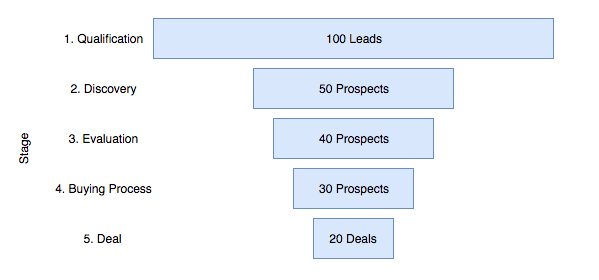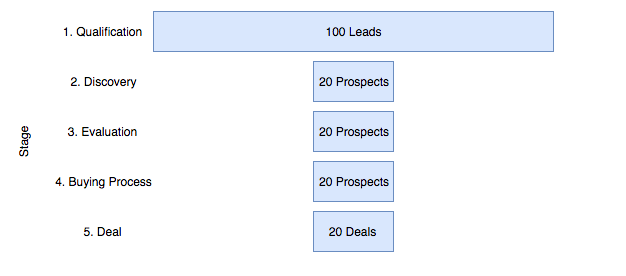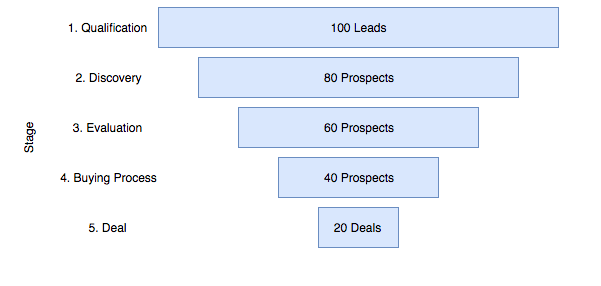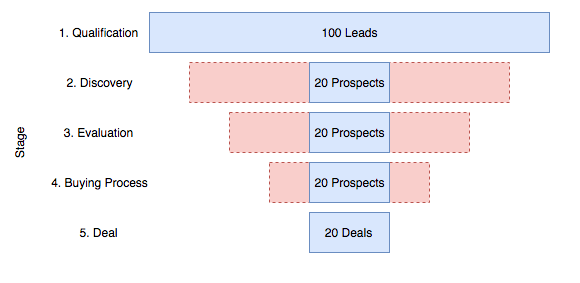A full funnel is a happy funnel, right? It means prospects love your product, your sales team is busy, and you’re going to win more deals.
Not quite. All it means is that your sales process has fallen at the very first hurdle—qualification. Without strong qualification you are wasting your reps’ time, losing money, and ruining any chance you have of developing an efficient sales process.
Qualification is paramount in sales. Here we break down how bad qualification can lead to so many problems in sales and beyond, and how you and your team can implement the best process to make sure you are getting the best customers.
Mo’ Prospects, Mo’ Problems
No sales rep wants to shrink their pipeline. With targets to hit each month, they want as many opportunities available to them as possible to make sure they reach quota. They all have confidence in their own ability to turn around any lackluster prospect.
In the short term, this thinking can crush your team’s ability to close deals, and in the long-term, it can kill your company’s ability to make money.
Short-term: losing time
But a rep’s most precious asset is time. Every minute spent on a prospect going nowhere is one missed with a prospect that could be turned into a great customer.
Let’s say you have a 5-stage sales funnel with a 5:1 lead-to-deal ratio that gradually whittles down prospects to the final deals:

Martini-glass sales funnel
At each stage, you have fewer and fewer prospects to work with. The negative view of this is that you are losing opportunities for deals as you go down the funnel.
But there is a more positive spin to put on this “martini-glass” type of funnel. At each stage you are freeing up your reps to work with better prospects. This becomes more obvious if we take it to the extreme, with a T-shaped funnel:

T-shaped funnel
Suddenly, all those going-nowhere prospects have gone. In this scenario, your reps would be spending all their time with future customers and would win all their deals. If the average time-in-stage is five days, this is an extra 250 days of time your reps now have. You have given them back their most important asset.
OK, so this is an ideal scenario. But, you don’t have that magical crystal ball that tells you to concentrate on the right lead versus the wrong one.
Except you do—qualification. Strong qualification criteria allow you to weed out prospects that aren’t going to become customers at the very top of your funnel. That way, they don’t waste your time, and you don’t waste their time. We can see why qualification is so vital if we flip the above model around. Let’s stick with the 5:1 ratio, but remove those initial qualification parameters:

Full funnel
This wide funnel gives us our full funnel. But it also reps a massive amount of extra work. This wide funnel would account for 300 more rep-days than the martini funnel. All for no extra revenue at the end. There are always only 20 great customers in that set of leads:

Difference in T-shaped and full funnels
Everything in red there is wasted effort, wasted time, and wasted money.
This is only the very start of the problem. Bad qualification can lead to:
- Longer sales cycles as reps try in vain to turn around bad prospects in each stage.
- More pipeline coverage needed as there are more opportunities in the pipeline at any given time.
- A higher percentage of opportunities pushed because reps presume they can still win prospects over at a later date.
Long-term: losing customers
The argument against all of the above is that some of those badly qualified prospects might actually buy, that through widening the funnel, you also widen that last number to 25 or 30 deals.
But this is to miss the fundamental point of qualification. Qualification lasts a lifetime. Qualification isn’t about finding a prospect that you can force through the funnel. It’s about finding the right customer for your product.
Well-qualified prospects turn into long-term customers. Badly-qualified prospects don’t. They churn. This makes the long-term issue with bad qualification even more pernicious. It causes problems for you and your customers:
- Negative value: Even if you closed the deal, ultimately you are not what this customer wants or needs. They are not your ideal customer and you are not their ideal product. That means sooner or later, they will churn out. Though you managed to get revenue from them for a time, you’ll lose revenue through negative word of mouth, as well as through increased customer acquisition costs.
- Product skew: If they aren’t well-qualified for your product then they’ll tell you about it. Feature requests and tickets with your support and success teams will go up as they try to turn your product into something that works for them. The more badly-qualified customers you have, the higher chance of success. Instead of having a product doing one job excellently for your ideal customers, you’ll have a product doing multiple jobs ineffectively for multiple customer types.
- Team time: Just as with the sales team, your success team’s time is also supremely valuable. You want that time spent helping customers that can do something great with your product, not with customers that shouldn’t be using it in the first place. By trying to get more deals closed, your sales team has pushed the problem down the road to the rest of your organization.
No qualification process is going to be 100% perfect. But if sales reps completely negate their qualification duties, they are not just wasting their own time, they are also wasting the time of everyone involved throughout both your company and your customers.
Strong Qualification Leads to Strong Customers
Qualification has to work within your larger sales process. If reps are allowed to qualify as they see fit, then they will always err on the side of more opportunities to close. To solve this problem you need two things: a thorough qualification process and the right incentives.
Better knowledge
Qualification starts with a better understanding of your prospects. Without knowing who they are and what they need, you can’t identify the people you can really help. The great thing is all this data is readily available before you even talk to leads.
Consider the most common qualification criteria: BANT. You need to know the Budget the prospect has, whether your contact has Authority to make the purchase, whether they have the Need for your product, and whether now is good Timing for them to buy.
You do this through research. The common way is to pound the phones and emails, chasing down this information from your leads. Through time and effort you’ll get the data, but it can be highly ambiguous information. No one wants to share their budgets up front, and some people are coy about giving reps information they think will be used against them.
That is where lead enrichment should come into your qualification process. Say you’re a marketing automation platform and your ideal customer profile is B2B companies with 100+ employees. Someone with an @hired.com email address requests contact. Before you even get on the call, you can pull up this information:

B2B. Check. 100+ employees. Check. Before a rep has wasted any of that most precious asset, they already know whether this is someone that is within their ICP envelope.
But then they can go further:

From this one graph they then can suddenly answer at least B, N, and T from above. This is a growing company, which means budgets are growing and needs for new tech are growing. They are also growing fast—2X in 12 months—meaning that the timing is critical as well. All that is left is to determine whether the person on the other end of the phone has the authority to make a buying decision.
This information arms the rep with pertinent details pre-qualification. They can still ask all the important questions on the call, but they already understand this customer and their needs.
This step can be taken a step further, by automating lead enrichment and incorporating into your lead scoring. Then, when a company that a) was within your ICP, b) with matching qualification criteria, c) reached out to you, you can automatically flag them, pull to the top of your contact list, and give reps the details they need for an immediate call.
Not only have you got a great qualification, but you’ve saved time doing it.
This saved time then allows you to build the flywheel of success. Every well-qualified prospect that becomes an ideal customer becomes fodder for finding more. Reps can use their saved time to discover more prospects that fit that criteria. This fills the top of the funnel with better quality customers. You’re widening it out again, but with customers that are fully qualified.
The right incentives
Incentives matter. If your reps are rewarded for the amount of deals won, this is what they’ll optimize for, no matter the quality of that deal.
Tying some sales compensation to the long-term health of a customer allows reps to shift their strategy towards customers that are going to be a success with your product. Two possible ways to do this are:
- Redistribute compensation throughout the year. This will mean that reps will want to minimize the churn from their accounts and therefore prioritize those prospects that are exactly within your Ideal Customer Profile.
- Give reps a cut of upsell. This allows reps to think even broader, looking not only for customers that match the ICP, but for ones that will have substantial success with your product and want to upgrade.
Incentive systems that think long-term allow you to align each of your teams. If marketing, sales, and customer success are all rewarded for customers that upsell, then your teams will work together to make sure this is the type of customer that will come to fill the top of your funnel.
Conclusion
Qualification isn’t a hurdle to get quickly over for your sales team. It is the start of the relationship with a new customer.
Do it wrong and everyone has a negative experience. Reps waste time, as does the prospect. You get churn and no revenue.
But get it right, and the experience is an entirely positive one. The customer gets a valued product, and your company gets a happy customer that will stay and upgrade. Reps get their deal, but safe in the knowledge that they have found a quality customer for the company. They also get something more precious—time—with which they can go out on the hunt for more and more customers, and more and more deals.
Also published on Medium.
